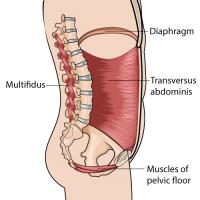Why is your Breathing important?
Breathing keeps you alive and is central to daily life. The rhythm, depth and technique of your breath varies with:
-
activity,
-
posture and,
-
your emotional state.
Your breathing affects activity, posture and emotion and your activity, posture and emotion affects your breathing.
Breathing muscles
Your breathing muscle are part of the core team surrounding the abdomen (see video below.) These are the pelvic floor, back and abdominal muscles.
This team is crucially important for a flexibly strong base for movement, projecting your voice and bracing at times of great effort and shock.
We hold our breath when we protect ourselves.
Breathing muscles are part of the core team: the diaphragm, abdominal, back and pelvic floor muscles.

Breathing is a key to improving many problems.
Let's discuss how we use comfortable attention to your quiet breath to help bladder, bowel, pain, stress and unhelpful postures.
We can pair quiet breathing and breath awareness.....
-
with pelvic floor muscle retraining,
-
to change postures which can worsen prolapse,
-
to promote the relaxation response,
-
to reduce overly tense local muscles,
-
to promote a flow from diaphragm to pelvic floor,
-
to calm persistent pain, unwanted thoughts and anxiety,
-
to prevent you from ‘bearing down' during emptying bladder and bowel,
-
to calm body sensations to assist with suppressing strong bladder and bowel urges.
How To Do Quiet Breathing
Positions
You can practice quiet breathing anywhere.
When you start, it helps to be supported and still.
Try whilst sitting, lying on your back or side, even on the floor with your lower legs elevated and resting on a couch or chair.
Technique
Here is the so simple technique. Place your hands as seen below to feel for the movement.
Taking unforced breaths, see if you can gently
- expand ribs sideways and belly rise on the inward breath and then
-
return to rest on the outward breath (ribs and belly naturally deflate,)
-
try to keep your upper chest relaxed while breathing.

Your goal is to create a soft, unforced, gentle breathing pattern which hopefully feels quite relaxing. You might like to imagine your lower ribs slightly expanding in all directions like partly opening an umbrella. Sometimes placing your hands above your head helps too.
Time
As a general guide you could consider creating moments of this sort of quiet mindful breathing 4-5 x/day for 1-2 minutes, but feel free to fit it into what works best for you (ie less/more often, a few breaths or up to 10 minutes).
But what if I feel uncomfortable?
Some people feel less comfortable and less relaxed when they focus on quiet breathing. Rest assured that you are not alone; this is a real response.
Don't worry. We will offer grounding techniques instead. You can use grounding in the same way as quiet breathing.

